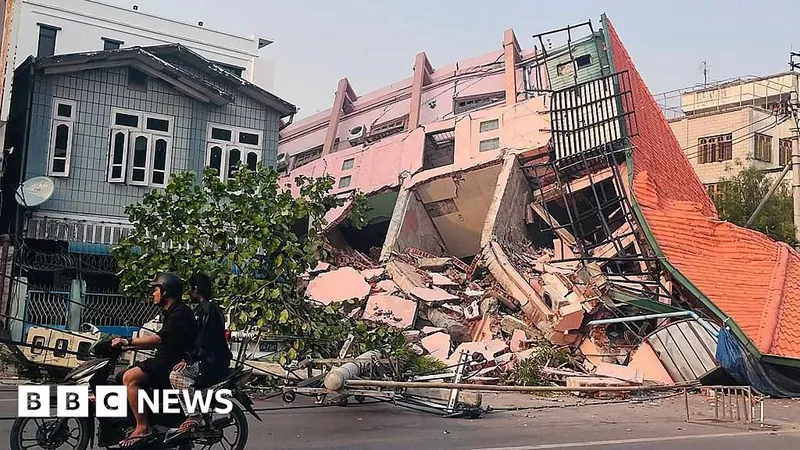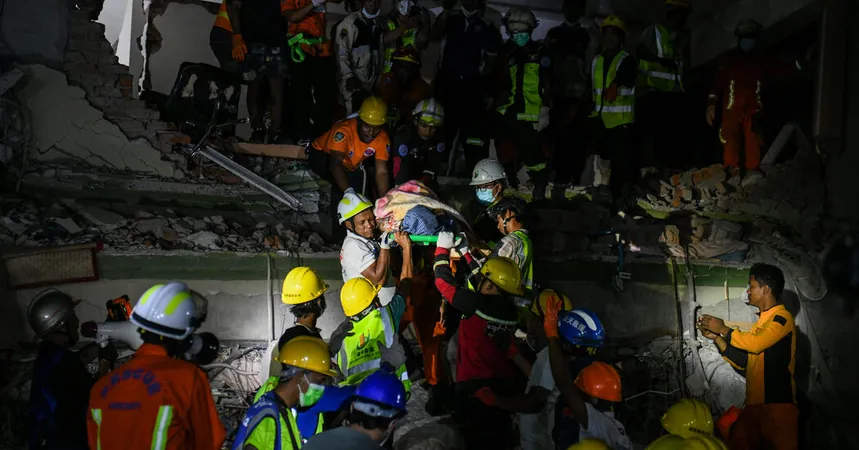
Deadly 7.7 Magnitude Earthquake Strikes Myanmar and Thailand: Casualties Rise Amid Chaos
2025-03-28
Author: Ming
Introduction
A catastrophic earthquake measuring 7.7 on the Richter scale has struck central Myanmar, leading to devastating consequences for the region, according to the United States Geological Survey (USGS). Reports confirm at least 144 fatalities and over 730 injuries in Myanmar, as stated by the military leader Min Aung Hlaing.
Epicenter and Immediate Impact
The earthquake’s epicenter was located about 16km (10 miles) northwest of Sagaing, unleashing powerful tremors that reverberated throughout the region, with reports of shaking felt as far away as southwest China and Thailand. In a tragic development, around 100 construction workers have been reported missing following the collapse of an unfinished high-rise building in Bangkok, where at least seven deaths have been confirmed.
Eyewitness Accounts
Eyewitness accounts from Mandalay, Myanmar’s second-largest city, describe the scene as one of overwhelming destruction. Experts anticipate that the total number of casualties will continue to rise as rescue operations unfold.
State of Emergency and Aftershocks
A state of emergency has been declared by Myanmar’s military government across six regions, with reports of infrastructure damage emerging from the capital, Nay Pyi Taw. Roads have buckled, complicating rescue efforts in the affected areas. Just 12 minutes after the initial quake, a secondary tremor struck, registering a magnitude of 6.4 with an epicenter located 18km (11.1 miles) south of Sagaing.
Historical Context
Historically, Myanmar, once known as Burma, has been plagued by political instability and conflict, particularly following the military coup in 2021, which has thwarted attempts at democratic governance. The country remains under the grip of military control, and communications and media access are heavily restricted, complicating relief efforts.
Relief Operations Complicated
Shocking new information indicates that relief operations are hindered by the military's control over aid distribution, with a recent call for international assistance made by the junta following the disaster. Observers fear that the complex realities on the ground may obstruct both search and rescue missions and effective delivery of humanitarian aid.
Rescue Efforts
Trapped survivors await help as rescue teams in villages near Mandalay reported inadequate access to essential machinery. One rescuer lamented, “We’re digging people out with our bare hands,” underscoring the dire circumstances. The earthquake has exacerbated an existing humanitarian crisis in Myanmar, where an estimated 3.5 million people are already displaced due to ongoing civil strife.
Challenges in Sagaing Region
The Sagaing region, which lies close to the quake's epicenter, has been a hotbed of conflict and is now becoming more challenging for aid groups to operate safely. Concerns have been voiced about the junta's history of politicizing aid, as the military often denies assistance to areas controlled by resistance groups.
Impact on Thailand
In Thailand, the earthquake caused significant panic, with buildings in the capital, Bangkok, evacuated, including hospitals treating critically ill patients. Remarkably, a woman managed to give birth on the street surrounded by medical staff amid the chaos. Search and rescue teams worked tirelessly through the night to locate stranded construction workers, deploying drones, sniffer dogs, and heavy machinery to facilitate the operation.
Conclusion
As the region continues to grapple with the aftermath, the world watches closely, hoping for swift relief and assistance for those affected by this unprecedented disaster. Stay tuned for further updates on this evolving situation as rescue operations continue and casualty numbers may escalate.



 Brasil (PT)
Brasil (PT)
 Canada (EN)
Canada (EN)
 Chile (ES)
Chile (ES)
 Česko (CS)
Česko (CS)
 대한민국 (KO)
대한민국 (KO)
 España (ES)
España (ES)
 France (FR)
France (FR)
 Hong Kong (EN)
Hong Kong (EN)
 Italia (IT)
Italia (IT)
 日本 (JA)
日本 (JA)
 Magyarország (HU)
Magyarország (HU)
 Norge (NO)
Norge (NO)
 Polska (PL)
Polska (PL)
 Schweiz (DE)
Schweiz (DE)
 Singapore (EN)
Singapore (EN)
 Sverige (SV)
Sverige (SV)
 Suomi (FI)
Suomi (FI)
 Türkiye (TR)
Türkiye (TR)
 الإمارات العربية المتحدة (AR)
الإمارات العربية المتحدة (AR)